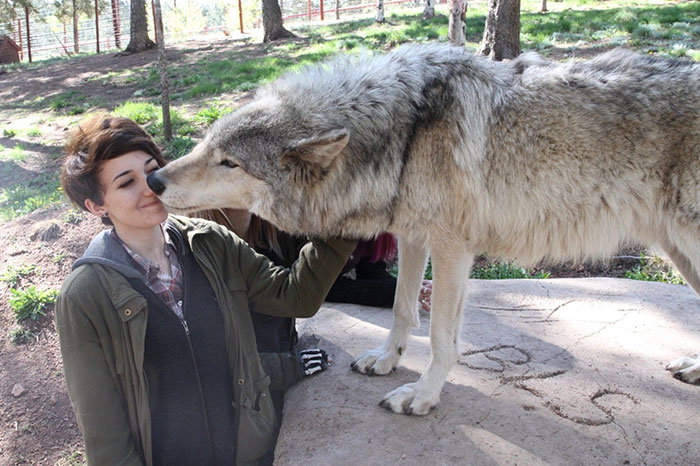Wolves are the subject of both enchantment and severe stigma that has led humans to drive them out of their natural habitats all over North America and Europe. To demystify what wolves are like in reality, some wolf sanctuary organizations offer meet and greets with their residents. A rescued wolf that is acclimated to humans and supervised by handlers is very different from a wild wolf, making this the safest setting in which you can meet a wolf and the only way that you should—wild wolves usually stay far away from humans, but in case of the small chance that you see one, messing with wild animals, especially large carnivores like wolves, is dangerous and potentially deadly.
Someone on Tumblr posted a picture that may be from a tour like this, and she couldn’t recommend it enough after leaving with the main takeaway that the majestic creature she was introduced to was basically just a huge doggo. While meeting a species ambassador can undoubtedly be fun, though, wolf sanctuaries have an important job, of which meet and greets like this are just one perk.
One Tumblr user was able to get up close to a wolf in captivity
Image credits: thewugtest
Others were curious about how one would possibly find this out
Image credits: sad-gay-potato
The answer is pretty adorable
Image credits: thewugtest
Image credits: thewugtest
Image credits: libertarirynn
A Colorado adventure columnist who attended a similar tour confirmed that wolves love giving the equivalent of a firm handshake with their tongues. Look at the rules and disclaimers on any advertisement for these tours, though, and it’s obvious that you need to take the responsibility seriously if you want a big, wet wolf kiss.
The Colorado Wolf and Wildlife Center in the town of Divide in central Colorado, for example, has an exhaustive list of dangling, protruding, or unsecured clothing and hairstyles that visitors may not be allowed into the wolf sanctuary wearing, with the blunt warning “wolves love to steal.”
The organization’s objective is to educate people about exploitative practices like the illegal fur and pet trade, from which many of their wolves who can no longer safely be returned to the wild were rescued. In the western United States, where wolves are heavily vilified as a threat to livestock, the organization also advocates for safely containing livestock, using non-lethal deterrents to keep predators away, and avoiding behavior that attracts wolves to human settlements, like feeding domestic animals outside.
Another subject they seek to educate people about is wolf-dog hybrids, which they emphasize are much more difficult to own than domestic dogs and not recommended for anybody who doesn’t have a secure and large outdoor enclosure, a qualified veterinarian and a lot of time and effort to devote to specialized training. A Texas organization dedicated to wolfdog rescue and advocacy adds that claiming that your dog is part wolf when they are not is a danger both to wolf hybrids, and to dogs with no wolf blood but a similar appearance. Falsely introducing your husky or German shepherd as part wolf could lead others to believe that wolfdog care is less demanding than it really is and obtain a wolfdog that will end up being confiscated or abandoned when they can’t provide proper care.
Wild wolves are known for their secrecy and in most parts of the world, you’re highly unlikely to see one. However, a community in Canada has encountered problems with wild wolves becoming too accustomed to humans’ presence in recent years, leading to aggressive wolves that have had to be shot after attacking humans and dogs. Wildlife researchers blame the change largely on people feeding and trying to approach them. They say it’s difficult to convince people to scare wolves away if they see them, but that this is the best course of action for both species’ safety.
If you want to get close to a wolf or any other wild animal, don’t go trying to befriend them in the wild. The best-case scenario is that you won’t find any, and the worst, that you could be injured or killed and the animal punished for it. Instead, go to research wildlife sanctuary organizations where you might be able to meet them in the presence of professional handlers and learn something about their role and ecological importance in the process.
Commenters expressed their envy and shared their experiences with wolves
Explore more of these tags
I met a Coyote once, but he was too busy ordering an anvil from ACME to pay me any attention
Pretty much of this is rubbish, I've met wolves and I love them, but they are wild animals and not petting animals. One zookeeper in Sweden were killed some years ago by a pack of wolves she known for many years. Not their fault, it's not natural for them to live behind fences meeting people like that.
Maria, agree 100 percent. Sometimes it's like animals don't have value unless we can make sense of them from our own human perspective. Wolves are wild animals and they don't need human contact.
Load More Replies...I imagine that *some* wolves might be affectionate and enjoy human company. BUT spreading information like this without proper warnings will just give some people the impression that a wolf is just a big dog, and that is not at all the case. I love wolves, I think they are gorgeous and important parts of the ecosystem, but people have to give them distance or people will get hurt. Such a stupid article!
Reread the article. These are wolves rescued from specific circumstances, who already have extensive human interaction, training, and are supervised by trained personnel. I met a 'wild' wolf once; at a sanctuary, where she's lived almost all her life, so she was habituated to seeing humans--and she was still behind a fence! She licked my fingers once, then retreated from all the noise (from idiots) into her den, and stayed there. I felt honored. Incidently, the yearlings were just as obnoxious and stupid as any other group of teenagers. And wolves like--love--peppermint. I didn't believe it till I saw it. Big hulking alpha wolf rolling on a peppermint candy like a cat with catnip. The main aim of the sanctuary was to eventually release those who could be into the wild. I hope they succeeded.
Load More Replies...I met a Coyote once, but he was too busy ordering an anvil from ACME to pay me any attention
Pretty much of this is rubbish, I've met wolves and I love them, but they are wild animals and not petting animals. One zookeeper in Sweden were killed some years ago by a pack of wolves she known for many years. Not their fault, it's not natural for them to live behind fences meeting people like that.
Maria, agree 100 percent. Sometimes it's like animals don't have value unless we can make sense of them from our own human perspective. Wolves are wild animals and they don't need human contact.
Load More Replies...I imagine that *some* wolves might be affectionate and enjoy human company. BUT spreading information like this without proper warnings will just give some people the impression that a wolf is just a big dog, and that is not at all the case. I love wolves, I think they are gorgeous and important parts of the ecosystem, but people have to give them distance or people will get hurt. Such a stupid article!
Reread the article. These are wolves rescued from specific circumstances, who already have extensive human interaction, training, and are supervised by trained personnel. I met a 'wild' wolf once; at a sanctuary, where she's lived almost all her life, so she was habituated to seeing humans--and she was still behind a fence! She licked my fingers once, then retreated from all the noise (from idiots) into her den, and stayed there. I felt honored. Incidently, the yearlings were just as obnoxious and stupid as any other group of teenagers. And wolves like--love--peppermint. I didn't believe it till I saw it. Big hulking alpha wolf rolling on a peppermint candy like a cat with catnip. The main aim of the sanctuary was to eventually release those who could be into the wild. I hope they succeeded.
Load More Replies...
 Dark Mode
Dark Mode 

 No fees, cancel anytime
No fees, cancel anytime 








































































256
57